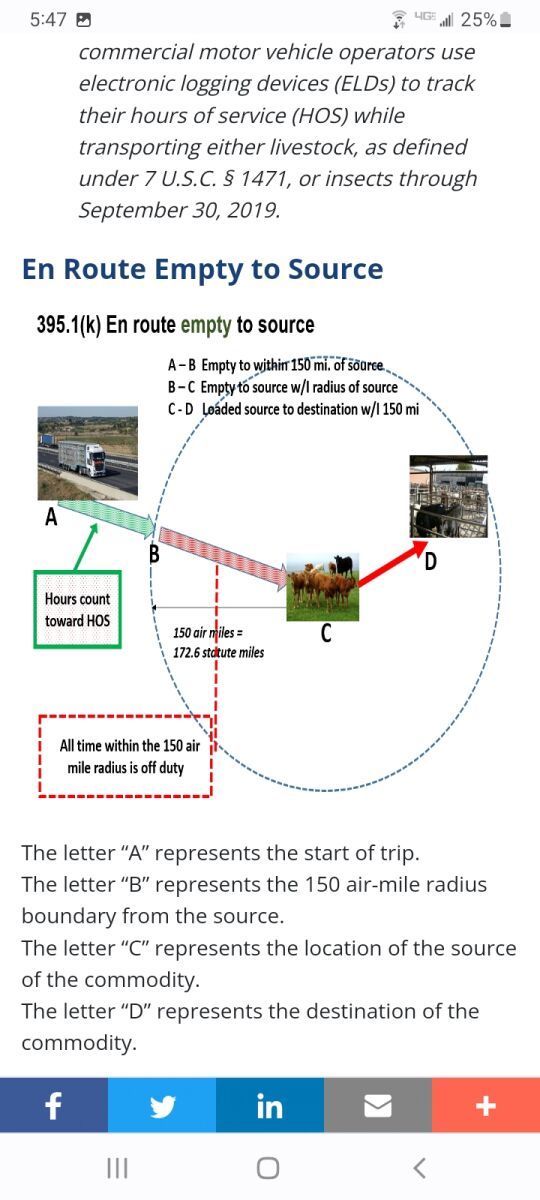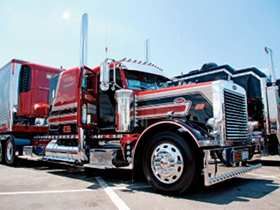Question In Regards To The AG Exemption
Topic 32616 | Page 1

I need a little bit more assitance trying to understand the AG Exemption, for example; If my terminal and load are within the 150 air mile radius, how should any Pre-Trip or Work (All time at a plant terminal or facility), be shown in my ELD (Motive)? On-Duty? Off-Duty? or should I show an On-Duty Pre-Trip once I leave the 150 air mile radius?
I read the FMCSA regulation before posting this comment.
The regulation doesn't specify anything regarding pre-trip and other duty functions other than to specify that maintaining a log is not necessary, per this exemption. If you anticipate going outside the 150-mile radius, I would have a pre-trip logged as soon as you start driving that day. The regulation states that you don't have to maintain an ELD or paper logs, under this exemption, but it also doesn't state that you can't maintain one of these logs. Log any duty functions as if you will go outside the 150-mile radius and then you are covered when it does happen without having to reverse engineer your day once you do exceed the 150-mile radius.
Terminal:
A facility where trucking companies operate out of, or their "home base" if you will. A lot of major companies have multiple terminals around the country which usually consist of the main office building, a drop lot for trailers, and sometimes a repair shop and wash facilities.
CSA:
Compliance, Safety, Accountability (CSA)
The CSA is a Federal Motor Carrier Safety Administration (FMCSA) initiative to improve large truck and bus safety and ultimately reduce crashes, injuries, and fatalities that are related to commercial motor vehicle
FMCSA:
Federal Motor Carrier Safety Administration
The FMCSA was established within the Department of Transportation on January 1, 2000. Their primary mission is to prevent commercial motor vehicle-related fatalities and injuries.
What Does The FMCSA Do?
- Commercial Drivers' Licenses
- Data and Analysis
- Regulatory Compliance and Enforcement
- Research and Technology
- Safety Assistance
- Support and Information Sharing
Fm:
Dispatcher, Fleet Manager, Driver Manager
The primary person a driver communicates with at his/her company. A dispatcher can play many roles, depending on the company's structure. Dispatchers may assign freight, file requests for home time, relay messages between the driver and management, inform customer service of any delays, change appointment times, and report information to the load planners.Frank, I'm not a Moderator here and certainly no expert. But, it looks like you have the right idea; that you don't have to log anything while working within the 150-mile radius. And yes, you'd do your pre-trip and normal log activities once you go beyond it. If you're a company driver though, I'd check with your company and make sure you're following their requirements, as long as they don't conflict with FMCSA.
I pulled the following from the FMCSA website;
"Once a driver operates beyond the 150 air-mile radius, the HOS regulations apply. Therefore, starting at the time and location where the transporter goes past the 150 air-mile radius, the driver must maintain logs using an ELD, unless the driver or the vehicle meets one of the limited ELD exemptions. The driver must work and drive within the limitations of the HOS rules when operating beyond the 150 air-mile radius. Time spent working within the 150 air-mile radius does not count toward the driver’s daily and weekly limits."
Hopefully, one of the more experienced Mods here (or one of the guys who regularly hauls local/ag) will chime in with the best advice.
CSA:
Compliance, Safety, Accountability (CSA)
The CSA is a Federal Motor Carrier Safety Administration (FMCSA) initiative to improve large truck and bus safety and ultimately reduce crashes, injuries, and fatalities that are related to commercial motor vehicle
FMCSA:
Federal Motor Carrier Safety Administration
The FMCSA was established within the Department of Transportation on January 1, 2000. Their primary mission is to prevent commercial motor vehicle-related fatalities and injuries.
What Does The FMCSA Do?
- Commercial Drivers' Licenses
- Data and Analysis
- Regulatory Compliance and Enforcement
- Research and Technology
- Safety Assistance
- Support and Information Sharing
Fm:
Dispatcher, Fleet Manager, Driver Manager
The primary person a driver communicates with at his/her company. A dispatcher can play many roles, depending on the company's structure. Dispatchers may assign freight, file requests for home time, relay messages between the driver and management, inform customer service of any delays, change appointment times, and report information to the load planners.HOS:
Hours Of Service
HOS refers to the logbook hours of service regulations.OWI:
Operating While Intoxicated

I read through all of the replies and want to offer commentary and advice. I move some AG products and never go outside of the 150 mile air radius. I do however log on-duty hours beginning when I clock-in and then clock-out regardless of hauling AG material or not; simply because I might have 5-6 loads in the course of my day that vary on material type and destination.
If you have a set route or series of set routes there is no reason to run paper logs if within 150 mile radius. However to Ryan’s point if mileage varies (over 150 at times), I suggest complying by logging all your activities and work days with paper logs if your truck is not equipped with an ELD (electronic logging device).
One other point, although pretrip and post trip on the AG exception does not require a log notation, it does NOT mean you are exempt from performing a proper pre and post trip.
With all that said… you absolutely must educate yourself using this FMCSA link:
And this one:
Discuss compliance with your employer also. They may want you to log everything, their prerogative.
Good luck!
CDL:
Commercial Driver's License (CDL)
A CDL is required to drive any of the following vehicles:
- Any combination of vehicles with a gross combined weight rating (GCWR) of 26,001 or more pounds, providing the gross vehicle weight rating (GVWR) of the vehicle being towed is in excess of 10,000 pounds.
- Any single vehicle with a GVWR of 26,001 or more pounds, or any such vehicle towing another not in excess of 10,000 pounds.
- Any vehicle, regardless of size, designed to transport 16 or more persons, including the driver.
- Any vehicle required by federal regulations to be placarded while transporting hazardous materials.
Logbook:
A written or electronic record of a driver's duty status which must be maintained at all times. The driver records the amount of time spent driving, on-duty not driving, in the sleeper berth, or off duty. The enforcement of the Hours Of Service Rules (HOS) are based upon the entries put in a driver's logbook.
CSA:
Compliance, Safety, Accountability (CSA)
The CSA is a Federal Motor Carrier Safety Administration (FMCSA) initiative to improve large truck and bus safety and ultimately reduce crashes, injuries, and fatalities that are related to commercial motor vehicle
FMCSA:
Federal Motor Carrier Safety Administration
The FMCSA was established within the Department of Transportation on January 1, 2000. Their primary mission is to prevent commercial motor vehicle-related fatalities and injuries.
What Does The FMCSA Do?
- Commercial Drivers' Licenses
- Data and Analysis
- Regulatory Compliance and Enforcement
- Research and Technology
- Safety Assistance
- Support and Information Sharing
DOT:
Department Of Transportation
A department of the federal executive branch responsible for the national highways and for railroad and airline safety. It also manages Amtrak, the national railroad system, and the Coast Guard.
State and Federal DOT Officers are responsible for commercial vehicle enforcement. "The truck police" you could call them.
Fm:
Dispatcher, Fleet Manager, Driver Manager
The primary person a driver communicates with at his/her company. A dispatcher can play many roles, depending on the company's structure. Dispatchers may assign freight, file requests for home time, relay messages between the driver and management, inform customer service of any delays, change appointment times, and report information to the load planners.HOS:
Hours Of Service
HOS refers to the logbook hours of service regulations.I am a little confused. It sounds like you are currently running an ELD? Are your trips normally outside a 150 mile radius? If so the exemption does not apply. You would just log the way you always do. Doing otherwise would leave gaps in your HOS as well as generating unidentified driver records on the ELD.
The purpose of the exemption is to allow companies/drivers who rarely operate outside the 150 mile radius to operate without logging, except when they exceed the 150 mile radius. It is not to allow a driver who normally operates under HOS logging requirements to take a day off from logging.
I apologize if I am mis reading the situation.
HOS:
Hours Of Service
HOS refers to the logbook hours of service regulations.
I am a little confused. It sounds like you are currently running an ELD? Are your trips normally outside a 150 mile radius? If so the exemption does not apply. You would just log the way you always do. Doing otherwise would leave gaps in your HOS as well as generating unidentified driver records on the ELD.
The purpose of the exemption is to allow companies/drivers who rarely operate outside the 150 mile radius to operate without logging, except when they exceed the 150 mile radius. It is not to allow a driver who normally operates under HOS logging requirements to take a day off from logging.
I apologize if I am mis reading the situation.
the 100/150 air mile radius is different than what the OP is asking about. Here's a diagram from the FMCSA

So just say the driver is starting their trip within 150 miles to pickup the load. They're able to legally drive that 150 miles off duty to pickup the load. They're also allowed to log the final 150 miles to the destination they're delivering it to off duty. Kinda scary to think these drivers are legally allowed to run 300 miles over their 11 drive clock which could mean another 5ish hours behind the wheel before you even factor in time spent getting loaded/unloaded.
OP I'm unable to give you an answer and be confident it's the correct way to do it. I would highly recommend you contact your company, or if you run under your own authority contact a local scale house. Iowa DOT (motor vehicle enforcement) is very active on Facebook I'll send them a message and see if I can get a response.
CSA:
Compliance, Safety, Accountability (CSA)
The CSA is a Federal Motor Carrier Safety Administration (FMCSA) initiative to improve large truck and bus safety and ultimately reduce crashes, injuries, and fatalities that are related to commercial motor vehicle
FMCSA:
Federal Motor Carrier Safety Administration
The FMCSA was established within the Department of Transportation on January 1, 2000. Their primary mission is to prevent commercial motor vehicle-related fatalities and injuries.
What Does The FMCSA Do?
- Commercial Drivers' Licenses
- Data and Analysis
- Regulatory Compliance and Enforcement
- Research and Technology
- Safety Assistance
- Support and Information Sharing
DOT:
Department Of Transportation
A department of the federal executive branch responsible for the national highways and for railroad and airline safety. It also manages Amtrak, the national railroad system, and the Coast Guard.
State and Federal DOT Officers are responsible for commercial vehicle enforcement. "The truck police" you could call them.
Fm:
Dispatcher, Fleet Manager, Driver Manager
The primary person a driver communicates with at his/her company. A dispatcher can play many roles, depending on the company's structure. Dispatchers may assign freight, file requests for home time, relay messages between the driver and management, inform customer service of any delays, change appointment times, and report information to the load planners.HOS:
Hours Of Service
HOS refers to the logbook hours of service regulations.As I mentioned I sent Iowa DOT Motor Vehicle Enforcement a message on Facebook. I sent
Good evening I have a couple quick questions I could use some guidance on. If a driver is using the ag exemption where they're not required to log the first 150 air miles until they're outside that radius how should they be showing that they've done a pretrip? Should they notate that before they begin their trip even though they're not required to have ELD/logs at that point, or are they expected to pull off when they go outside the 150 mile radius and log their pretrip? Also if they're doing work related activities at the terminal (in addition to pretrip inspection) before starting their trip is that still required to be logged on duty (not driving)?
Also one thing out of curiosity I often see conflicting information on is the legal limit for commercial drivers. Is the .04 the limit only when they're behind the wheel of a commercial vehicle or does the .04 also apply if you're a cdl holder but driving a prius? I'm not a drinker myself but enjoy knowing facts instead of believing conflicting rumors online.
Thank you for all you do to keep us safe.
The response I got back is :
They wouldn't be required to show it besides the fact they should still be filling out an inspection sheet. If they are within the 150 the logbook regs don't apply. They don't need to log anything. The .04 regulation only applies when the driver is operating a CDL required vehicle (very popular question).
CDL:
Commercial Driver's License (CDL)
A CDL is required to drive any of the following vehicles:
- Any combination of vehicles with a gross combined weight rating (GCWR) of 26,001 or more pounds, providing the gross vehicle weight rating (GVWR) of the vehicle being towed is in excess of 10,000 pounds.
- Any single vehicle with a GVWR of 26,001 or more pounds, or any such vehicle towing another not in excess of 10,000 pounds.
- Any vehicle, regardless of size, designed to transport 16 or more persons, including the driver.
- Any vehicle required by federal regulations to be placarded while transporting hazardous materials.
Logbook:
A written or electronic record of a driver's duty status which must be maintained at all times. The driver records the amount of time spent driving, on-duty not driving, in the sleeper berth, or off duty. The enforcement of the Hours Of Service Rules (HOS) are based upon the entries put in a driver's logbook.
Terminal:
A facility where trucking companies operate out of, or their "home base" if you will. A lot of major companies have multiple terminals around the country which usually consist of the main office building, a drop lot for trailers, and sometimes a repair shop and wash facilities.
DOT:
Department Of Transportation
A department of the federal executive branch responsible for the national highways and for railroad and airline safety. It also manages Amtrak, the national railroad system, and the Coast Guard.
State and Federal DOT Officers are responsible for commercial vehicle enforcement. "The truck police" you could call them.
OWI:
Operating While Intoxicated

Thank you all for the kind replies, you all have been very helpful!
New Reply:
New! Check out our help videos for a better understanding of our forum features

















Preview:








 TT On Facebook
TT On Facebook
I need a little bit more assitance trying to understand the AG Exemption, for example; If my terminal and load are within the 150 air mile radius, how should any Pre-Trip or Work (All time at a plant terminal or facility), be shown in my ELD (Motive)? On-Duty? Off-Duty? or should I show an On-Duty Pre-Trip once I leave the 150 air mile radius?
Terminal:
A facility where trucking companies operate out of, or their "home base" if you will. A lot of major companies have multiple terminals around the country which usually consist of the main office building, a drop lot for trailers, and sometimes a repair shop and wash facilities.